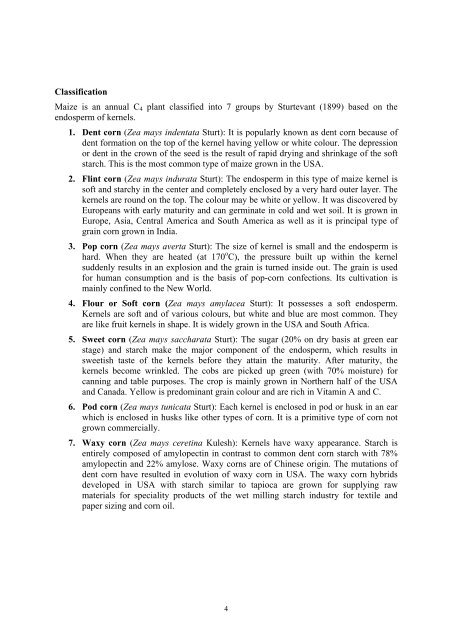Create successful ePaper yourself
Turn your PDF publications into a flip-book with our unique Google optimized e-Paper software.
Classification<br />
Maize is an annual C4 plant classified into 7 groups by Sturtevant (1899) based on the<br />
endosperm of kernels.<br />
1. Dent corn (Zea mays indentata Sturt): It is popularly known as dent corn because of<br />
dent formation on the top of the kernel having yellow or white colour. The depression<br />
or dent in the crown of the seed is the result of rapid drying and shrinkage of the soft<br />
starch. This is the most common type of <strong>maize</strong> grown in the USA.<br />
2. Flint corn (Zea mays indurata Sturt): The endosperm in this type of <strong>maize</strong> kernel is<br />
soft and starchy in the center and completely enclosed by a very hard outer layer. The<br />
kernels are round on the top. The colour may be white or yellow. It was discovered by<br />
Europeans with early maturity and can germinate in cold and wet soil. It is grown in<br />
Europe, Asia, Central America and South America as well as it is principal type of<br />
grain corn grown in India.<br />
3. Pop corn (Zea mays averta Sturt): The size of kernel is small and the endosperm is<br />
hard. When they are heated (at 170 o C), the pressure built up within the kernel<br />
suddenly results in an explosion and the grain is turned inside out. The grain is used<br />
for human consumption and is the basis of pop-corn confections. Its cultivation is<br />
mainly confined to the New World.<br />
4. Flour or Soft corn (Zea mays amylacea Sturt): It possesses a soft endosperm.<br />
Kernels are soft and of various colours, but white and blue are most common. They<br />
are like fruit kernels in shape. It is widely grown in the USA and South Africa.<br />
5. Sweet corn (Zea mays saccharata Sturt): The sugar (20% on dry basis at green ear<br />
stage) and starch make the major component of the endosperm, which results in<br />
sweetish taste of the kernels before they attain the maturity. After maturity, the<br />
kernels become wrinkled. The cobs are picked up green (with 70% moisture) for<br />
canning and table purposes. The crop is mainly grown in Northern half of the USA<br />
and Canada. Yellow is predominant grain colour and are rich in Vitamin A and C.<br />
6. Pod corn (Zea mays tunicata Sturt): Each kernel is enclosed in pod or husk in an ear<br />
which is enclosed in husks like other types of corn. It is a primitive type of corn not<br />
grown commercially.<br />
7. Waxy corn (Zea mays ceretina Kulesh): Kernels have waxy appearance. Starch is<br />
entirely composed of amylopectin in contrast to common dent corn starch with 78%<br />
amylopectin and 22% amylose. Waxy corns are of Chinese origin. The mutations of<br />
dent corn have resulted in evolution of waxy corn in USA. The waxy corn hybrids<br />
developed in USA with starch similar to tapioca are grown for supplying raw<br />
materials for speciality products of the wet milling starch industry for textile and<br />
paper sizing and corn oil.<br />
4

















